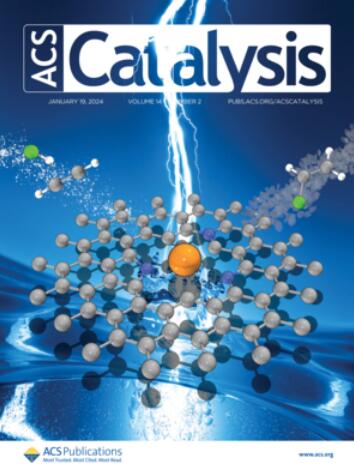Emulsion of Benzene and Water Phases by an Amphiphilic Hematite/Carbon Nitride Photocatalyst for Phenol Synthesis
IF 13.1
1区 化学
Q1 CHEMISTRY, PHYSICAL
引用次数: 0
Abstract
Photocatalytic hydroxylation of benzene in water using H2O2 as the oxidant is a green approach toward phenol synthesis. However, the immiscibility of benzene in water results in poor photocatalytic performance and a low efficiency of H2O2 utilization. To enhance drastically the affinity between the aqueous and nonaqueous phases, an amphiphilic heterojunction (Fe2O3/crystalline carbon nitride (CCN)) has been synthesized by intimately immobilizing hematite (Fe2O3) nanoparticles on a CCN surface for the photocatalytic hydroxylation of benzene to phenol. The unique amphiphilicity of Fe2O3/CCN allows the formation and stabilization of homogeneous emulsions in a benzene/water mixture to increase the effective oil/water interface area for more efficient mass transport. Moreover, the well-established type II heterojunction between Fe2O3 and CCN facilitates the fast separation and transfer of photoelectrons from CCN to Fe2O3 for the photo-Fenton activation of H2O2 with high utilization efficiency. We recorded a maximum phenol conversion of 31.6% by using a stoichiometric amount of H2O2 (10 mmol) on the photocatalytic hydroxylation of benzene. The apparent quantum yield of phenol production at λ = 420 nm was determined to be 47.1%. This amphiphilic photocatalyst approach would be useful for realizing other advanced oxidation reactions involving immiscible components.

两亲性赤铁矿/氮化碳光催化剂制备苯与水相乳化液合成苯酚
以H2O2为氧化剂光催化苯羟基化反应是一种绿色的苯酚合成方法。但苯在水中的不混溶性导致光催化性能差,对H2O2的利用效率低。为了大幅提高水相和非水相之间的亲和性,通过在CCN表面紧密固定赤铁矿(Fe2O3)纳米颗粒,合成了两亲性异质结(Fe2O3/结晶碳氮(CCN)),用于光催化苯羟基化成苯酚。Fe2O3/CCN独特的两亲性允许在苯/水混合物中形成和稳定均相乳液,从而增加有效的油/水界面面积,从而更有效地进行质量传输。此外,Fe2O3与CCN之间建立的II型异质结有利于光电子从CCN向Fe2O3的快速分离和转移,从而实现H2O2的光- fenton活化,具有较高的利用率。使用化学计量量的H2O2 (10 mmol)对苯的光催化羟基化反应,最大苯酚转化率为31.6%。在λ = 420 nm处,苯酚的表观量子产率为47.1%。这种两亲性光催化剂方法将有助于实现其他涉及不混相组分的高级氧化反应。
本文章由计算机程序翻译,如有差异,请以英文原文为准。
求助全文
约1分钟内获得全文
求助全文
来源期刊

ACS Catalysis
CHEMISTRY, PHYSICAL-
CiteScore
20.80
自引率
6.20%
发文量
1253
审稿时长
1.5 months
期刊介绍:
ACS Catalysis is an esteemed journal that publishes original research in the fields of heterogeneous catalysis, molecular catalysis, and biocatalysis. It offers broad coverage across diverse areas such as life sciences, organometallics and synthesis, photochemistry and electrochemistry, drug discovery and synthesis, materials science, environmental protection, polymer discovery and synthesis, and energy and fuels.
The scope of the journal is to showcase innovative work in various aspects of catalysis. This includes new reactions and novel synthetic approaches utilizing known catalysts, the discovery or modification of new catalysts, elucidation of catalytic mechanisms through cutting-edge investigations, practical enhancements of existing processes, as well as conceptual advances in the field. Contributions to ACS Catalysis can encompass both experimental and theoretical research focused on catalytic molecules, macromolecules, and materials that exhibit catalytic turnover.
 求助内容:
求助内容: 应助结果提醒方式:
应助结果提醒方式:


